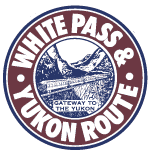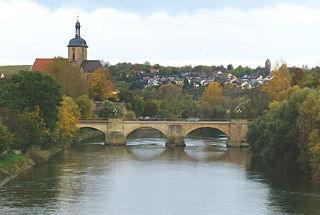
The Welshpool and Llanfair Light Railway (W&LLR) is a 2 ft 6 in narrow gauge heritage railway in Powys, Wales. The line is around 8.5 miles (13.7 km) long and runs westwards from the town of Welshpool via Castle Caereinion to the village of Llanfair Caereinion.

The White Pass and Yukon Route is a Canadian and U.S. Class III 3 ft narrow-gauge railroad linking the port of Skagway, Alaska, with Whitehorse, the capital of Yukon. An isolated system, it has no direct connection to any other railroad. Equipment, freight and passengers are ferried by ship through the Port of Skagway, and via road through a few of the stops along its route.

The Welsh Highland Railway is a 25-mile (40.2 km) long, restored 1 ft 11+1⁄2 in narrow gauge heritage railway in the Welsh county of Gwynedd, operating from Caernarfon to Porthmadog, and passing through a number of popular tourist destinations including Beddgelert and the Aberglaslyn Pass. At Porthmadog it connects with the Ffestiniog Railway and to the short Welsh Highland Heritage Railway. In Porthmadog it uses the United Kingdom's only mixed gauge flat rail crossing.

The Belgrave line is a commuter railway line in the city of Melbourne, Victoria, Australia. Operated by Metro Trains Melbourne, it is the city's fourth-longest metropolitan railway line at 41.8 kilometres (26.0 mi). The line runs from Flinders Street station in central Melbourne to Belgrave station in the east, serving 31 stations via Burnley, Box Hill, Ringwood, and Upper Ferntree Gully. Beyond Belgrave, the narrow-gauge line has been restored as the Puffing Billy Railway, which runs tourist services to the original terminus of Gembrook. The line operates for approximately 19 hours a day with 24 hour service available on Friday and Saturday nights. During peak hours, headways of up to 15 minutes are operated, with services every 20–30 minutes during off-peak hours. Trains on the Belgrave line run in a two three-car formations of X'Trapolis 100 trainsets.

The British Rail Class 114 diesel multiple units were built by BR Derby from September 1956 to July 1957. Forty-nine 2-car units were built, numbered E50001-49 for driving motors and E56001-49 for driving trailers. The units were used in the early days out of 40A Lincoln TMD (LN) on services all over the county, although a small number were transferred to 41A Sheffield (Darnall) during 1959/60.

The Breckland line is a secondary railway line in the east of England that links Cambridge in the west to Norwich in the east. The line runs through three counties: Cambridgeshire, Suffolk and Norfolk. It takes its name from the Breckland region of Norfolk and passes through Thetford Forest.
The Londonderry and Lough Swilly Railway Company was an Irish public transport and freight company that operated in parts of County Londonderry and County Donegal between 1853 and 2014. Incorporated in June 1853, it once operated 99 miles of railways. It began the transition to bus and road freight services in 1929. It closed its last railway line in July 1953 but continued to operate bus services under the name Lough Swilly Bus Company until April 2014, becoming the oldest railway company established in the Victorian era to continue trading as a commercial concern into the 21st century. Following a High Court petition by HM Revenue and Customs, the company went into liquidation and operated its final bus services on 19 April 2014.

Blaenau Ffestiniog railway station serves the slate mining town of Blaenau Ffestiniog, Wales, and is the passenger terminus of the Conwy Valley Line from Llandudno Junction. Transport for Wales Rail operate through services to Llandudno Junction and Llandudno. The station is a joint station with the narrow gauge Ffestiniog Railway, which operates primarily tourist passenger services to Porthmadog throughout most of the year. A feature of the standard gauge service is the availability on trains and buses of the popular "Gwynedd Red Rover" day ticket.

Penrhyn railway station on the Ffestiniog Railway is located on a restricted site at Pen-y-Bwlch above the town of Penrhyndeudraeth.

Rail transport in South Africa is an important element of the country's transport infrastructure. All major cities are connected by rail, and South Africa's railway system is the most highly developed in Africa. The South African rail industry is publicly owned.

Würzburg Hauptbahnhof is a railway station for the city of Würzburg in the German state of Bavaria. It was opened in 1864 to the north of the inner city as a replacement for the former Ludwigsbahnhof in the city centre, the capacity of which had been exhausted by the dramatic increase of rail traffic. Even today, Würzburg station is one of the major stations in Bavaria, since it lies at the intersection of several heavily used rail corridors. In particular, the routes in the north–south direction from Hamburg and Bremen to Munich as well as in west–east direction from the Rhine-Ruhr and Rhine-Main to Nuremberg and Vienna. Apart from Aschaffenburg Hauptbahnhof, Würzburg is the only station in Lower Franconia to be served by Intercity-Express services. With its combination of rail, tram and bus services, the station is the main hub for public transport in the city and the district of Würzburg.

Lauffen am Neckar or simply Lauffen is a town in the district of Heilbronn, Baden-Württemberg, Germany. It is on the river Neckar, 9 kilometres southwest of Heilbronn. The town is famous as the birthplace of the poet Friedrich Hölderlin and for its quality wines – in particular the "Lauffener Katzenbeißer Schwarzriesling".

The Solør Line is a 93.6-kilometer (58.2 mi) railway line that runs through district of Solør in Innlandet county, Norway. The line connects the Kongsvinger Line at Kongsvinger Station with the Røros Line at Elverum Station, running through the municipalities of Kongsvinger, Grue, Åsnes, Våler and Elverum. The standard gauge line lacks electrification and centralized traffic control; it is solely used by freight trains, mostly hauling lumber and wood chippings.

Göttingen railway station, known in German as Bahnhof Göttingen, is an InterCityExpress stop on Germany's domestic long-distance rail network and the only passenger station of the city of Göttingen. Built in 1854 as the terminus of the Hanoverian Southern Railway, the station lies west of the medieval town centre. The station today has four platform islands each with two through tracks. In addition there is a through track for goods traffic between the station building and the platforms.

The Zabergäu Railway (Zabergäubahn) was a spur line from the Franconia Railway. It ran for 20.3 km from Lauffen am Neckar to Leonbronn through an area known as the Zabergäu. Originally built with narrow gauge, it was converted to standard gauge in the 1960s.

The Friedewald train collision was a railway accident on 12 September 2009 in Saxony, Germany. It involved two steam-hauled passenger trains of the narrow gauge heritage Radebeul–Radeburg railway. One hundred and twenty-one people were injured, four of them seriously. Substantial damage was sustained by the locomotives and rolling stock.

The Frose–Quedlinburg railway, also called the Balkan ("Balkans") locally, was a standard gauge branch line on the northern rim of the Harz Mountains in the German state of Saxony-Anhalt. The line runs from Frose via Gernrode to Quedlinburg. It was closed in 2004. The Gernrode–Quedlinburg section was subsequently converted by the Harz Narrow Gauge Railway Company to metre gauge. Since 26 June 2006 the line has been re-opened as part of the Selke Valley Railway.

Quedlinburg station is a station on the Magdeburg–Thale railway in Quedlinburg in the German state of Saxony-Anhalt. It was built in 1862 as a through station on the southern edge of the town. The Gothic Revival entrance building of 1862, together with the other parts of the nearly complete Gründerzeit ensemble, is heritage-protected.


















